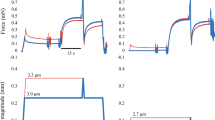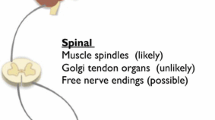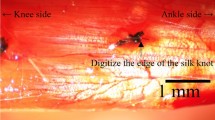Abstract
Purpose
The purpose of the present study was to determine the effect of the short latency stretch reflex on passive and active muscle stiffness in the soleus muscle.
Methods
Fourteen males participated in this study. Passive muscle stiffness was calculated from passive muscle force and fascicle length during passive lengthening at four different angular velocities (5, 50, 100, and 200 deg s−1). Active muscle stiffness was also calculated according to changes in muscle force and fascicle length during fast lengthening at five different angular velocities (100, 200, 300, 500, and 600 deg s−1) after submaximal isometric contraction (30% of maximal voluntary contraction). During the measurements of passive and active muscle stiffness, the amplitude of the short latency stretch reflex in the soleus muscle was measured.
Results
Change in passive torque and passive muscle stiffness significantly increased, whereas change in the fascicle length decreased, as angular velocity increased. At 100 and 200 deg s−1 (stretch reflex responses were not observed at 5 and 50 deg s−1), the amplitude of the short latency stretch reflex was highly correlated with passive muscle stiffness. Change in torque and active muscle stiffness were highest at 100 deg s−1 and decreased as angular velocity increased. At all angular velocities under active conditions, the amplitude of the short latency stretch reflex was not correlated with active muscle stiffness.
Conclusion
These results suggest that the short latency stretch reflex affects passive muscle stiffness in the soleus muscle, but not active muscle stiffness.








Similar content being viewed by others
Abbreviations
- ANOVA:
-
Analysis of variance
- EMG:
-
Electromyographic activity
- Fm:
-
Muscle force
- MA:
-
Moment arm length
- MVC:
-
Maximal voluntary contraction
- SD:
-
Standard deviation
- SOL:
-
Soleus muscle
- TQ:
-
Torque
References
Avela J, Komi PV (1998) Reduced stretch reflex sensitivity and muscle stiffness after long-lasting stretch-shortening cycle exercise in humans. Eur J Appl Physiol 78:403–410
Cronin NJ, Peltonen J, Ishikawa M, Komi PV, Avela J, Sinkjaer T, Voigt M (2008) Effects of contraction intensity on muscle fascicle and stretch reflex behavior in the human triceps surae. J Appl Physiol 105:226–232
Cronin NJ, Rantalainen T, Avela J (2015) Triceps surae fascicle stretch is poorly correlated with short latency stretch reflex size. Muscle Nerve 52:245–251
Eng JJ, Hoffer JA (1997) Regional variability of stretch reflex amplitude in the cat medial gastrocnemius muscle during a postural task. J Neurophysiol 78:1150–1154
Fellows SJ, Thilmann AF (1989) The role of joint biomechanics in determining stretch reflex latency at the normal human ankle. Exp Brain Res 77:135–139
Fukunaga T, Roy RR, Shellock FG, Hodgson JA, Edgerton VR (1996) Specific tension of human plantar flexors and dorsiflexors. J Appl Physiol 80:158–165
Gajdosik RL, Vander Linden DW, McNair PJ, Riggin TJ, Albertson JS, Mattick DJ, Wegley JC (2005) Viscoelastic properties of short calf muscle-tendon units of older women: effects of slow and fast passive dorsiflexion stretches in vivo. Eur J Appl Physiol 95:131–139
Grosset JF, Mora I, Lambertz D, Perot C (2007) Changes in stretch reflexes and muscle stiffness with age in prepubescent children. J Appl Physiol 102:2352–2360
Hoang PD, Herbert RD, Todd G, Gorman RB, Gandevia SC (2007) Passive mechanical properties of human gastrocnemius muscle-tendon units, muscle fascicles and tendons in vivo. J Exp Biol 210:4159–4168
Horita T, Komi PV, Nicol C, Kyrolainen H (1996) Stretch shortening cycle fatigue: interactions among joint stiffness, reflex, and muscle mechanical performance in the drop jump. Eur J Appl Physiol 73:393–403
Kawakami Y, Ichinose Y, Fukunaga T (1998) Architectural and functional features of human triceps surae muscles during contraction. J Appl Physiol 85:398–404
Kawakami Y, Amemiya K, Kanehisa H, Ikegawa S, Fukunaga T (2000) Fatigue responses of human triceps surae muscles during repetitive maximal isometric contractions. J Appl Physiol 88:1969–1975
Kawashima N, Nakazawa K, Yamamoto S, Nozaki D, Akai M, Yano H (2004) Stretch reflex excitability of the anti-gravity ankle extensor muscle in elderly humans. Acta Physiol Scand 180:99–105
Kubo K (2014) Active muscle stiffness in the human medial gastrocnemius muscle in vivo. J Appl Physiol 117:1020–1026
Kubo K, Ikebukuro T (2019) Changes in joint, muscle, and tendon stiffness following repeated hopping exercise. Physiol Rep 7:e14237
Kubo K, Ishigaki T, Ikebukuro T (2017) Effects of plyometric and isometric training on muscle and tendon stiffness in vivo. Physiol Rep 5:e13374
Kubo K, Ishigaki T, Ikebukuro T (2018) Measurement of active muscle stiffness with and without the stretch reflex. J Biomech 73:50–59
Kubo K, Ikebukuro T, Yata H (2020) Effect of angular velocity on active muscle stiffness in vivo. J Biomech 111:110007
Lamontagne A, Malouin F, Richards CL (1997) Viscoelastic behavior of plantar flexor muscle-tendon unit at rest. J Orthop Sports Phys Ther 26:244–252
Maganaris CN (2001) Force-length characteristics of in vivo human skeletal muscle. Acta Physiol Scand 172:279–285
Maganaris CN, Baltzopoulos V, Sargeant AJ (1998) Changes in Achilles tendon moment arm from rest to maximum isometric plantarflexion: in vivo observations in man. J Physiol 510:977–9852
Matthews PBC (1986) Observations on the automatic compensation of reflex gain on varying the pre-existing level of motor discharge in man. J Physiol 374:73–90
McNair PJ, Hewson DJ, Dombroski E, Stanley SN (2002) Stiffness and passive peak force changes at the ankle joint: the effect of different joint angular velocities. Clin Biomech 17:536–540
Muraoka T, Muramatsu T, Takeshita D, Kawakami Y, Fukunaga T (2002) Length change of human gastrocnemius aponeurosis and tendon during passive joint motion. Cells Tissues Organs 171:260–268
Obata H, Kawashima N, Ohtsuki T, Nakazawa K (2012) Aging effects on posture-related modulation of stretch reflex excitability in the ankle muscles in humans. J Electro Kinesiol 22:31–36
Ogawa T, Kawashima N, Suzuki S, Nakazawa K (2012) Different modulation pattern of spinal stretch reflex excitability in highly trained endurance runners. Eur J Appl Physiol 112:3641–3648
Price TB, Kamen G, Damon BM, Knight CA, Applegate B, Gore JC, Eward K, Signorile JF (2003) Comparison of MRI with EMG to study muscle activity associated with dynamic plantar flexion. Magn Reson Imaging 21:853–861
Proske U, Rack PMH (1976) Short-range stiffness of slow fibers and twitch fibers in reptilian muscle. Am J Physiol 231:449–453
Sousa F, Ishikawa M, Vilas-Boas JP, Komi PV (2007) Intensity- and muscle-specific fascicle behavior during human drop jumps. J Appl Physiol 102:382–389
Suzuki T, Sugawara K, Iizuka Y, Kubo K (2020) Effects of static stretching on active muscle stiffness with and without the stretch reflex. J Phys Fitness Sports Med 9:37–41
Voigt M, Dyhre-Poulsen P, Simonsen EB (1998) Modulation of short latency stretch reflexes during human hopping. Acta Physiol Scand 163:181–194
Walmsley B, Proske U (1981) Comparison of stiffness of soleus and medial gastrocnemius muscles in cats. J Neurophysiol 46:250–259
Funding
This study was supported by a Grant-in-Aid for Scientific Research (B) (20H04070 to K. Kubo) from the Japan Society for the Promotion of Science.
Author information
Authors and Affiliations
Contributions
The author (I) approved to submit this manuscript. The contributions of the author were as follows; KK conceived and designed the research, performed experiments, analyzed data, prepared figures, drafted and edited the manuscript.
Corresponding author
Ethics declarations
Conflict of interest
We have no conflict of interest with this work.
Additional information
Communicated by Nicolas Place.
Publisher's Note
Springer Nature remains neutral with regard to jurisdictional claims in published maps and institutional affiliations.
Rights and permissions
About this article
Cite this article
Kubo, K. Effect of short latency stretch reflex on passive and active muscle stiffness in the soleus muscle in vivo. Eur J Appl Physiol 122, 1303–1312 (2022). https://doi.org/10.1007/s00421-022-04930-6
Received:
Accepted:
Published:
Issue Date:
DOI: https://doi.org/10.1007/s00421-022-04930-6




